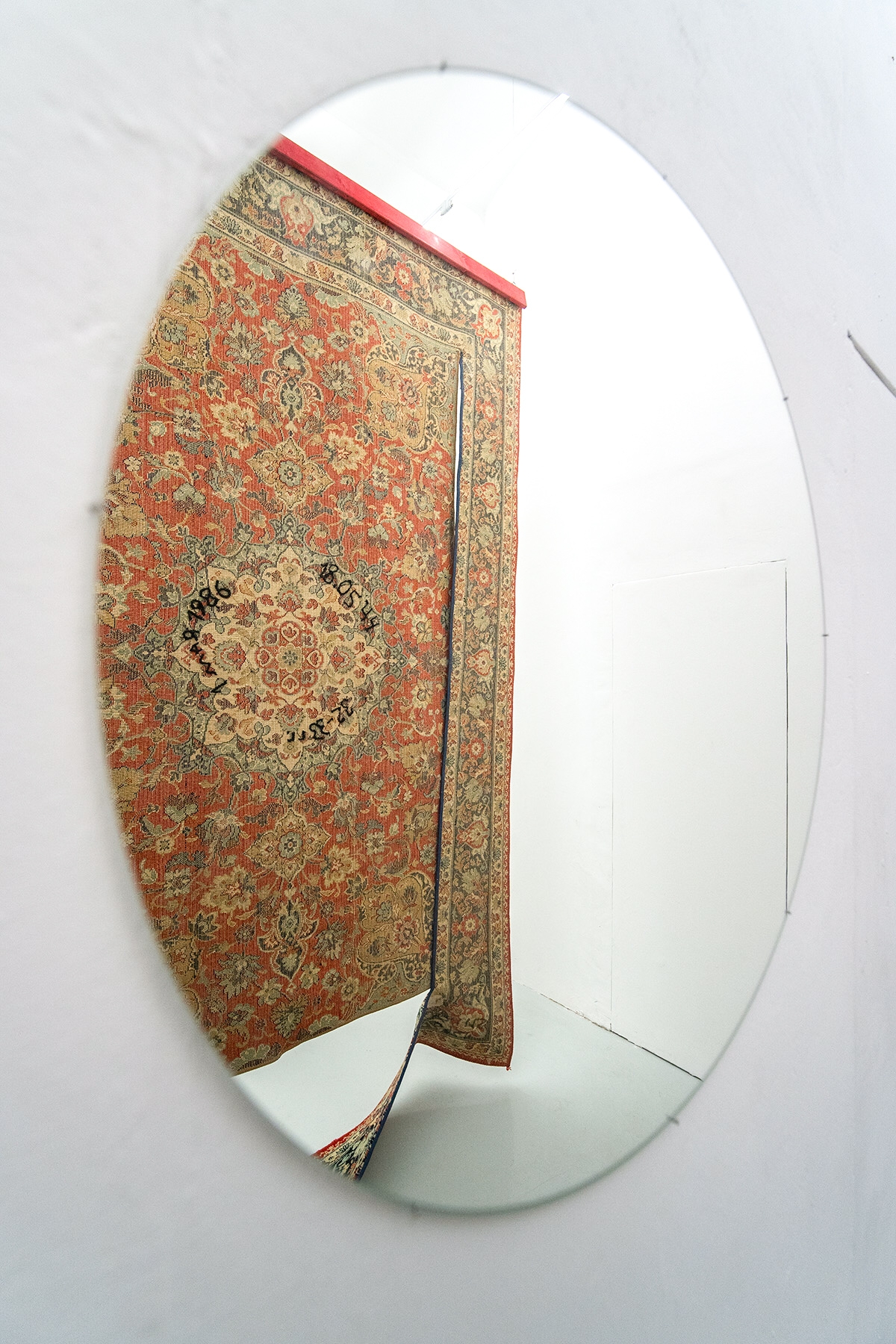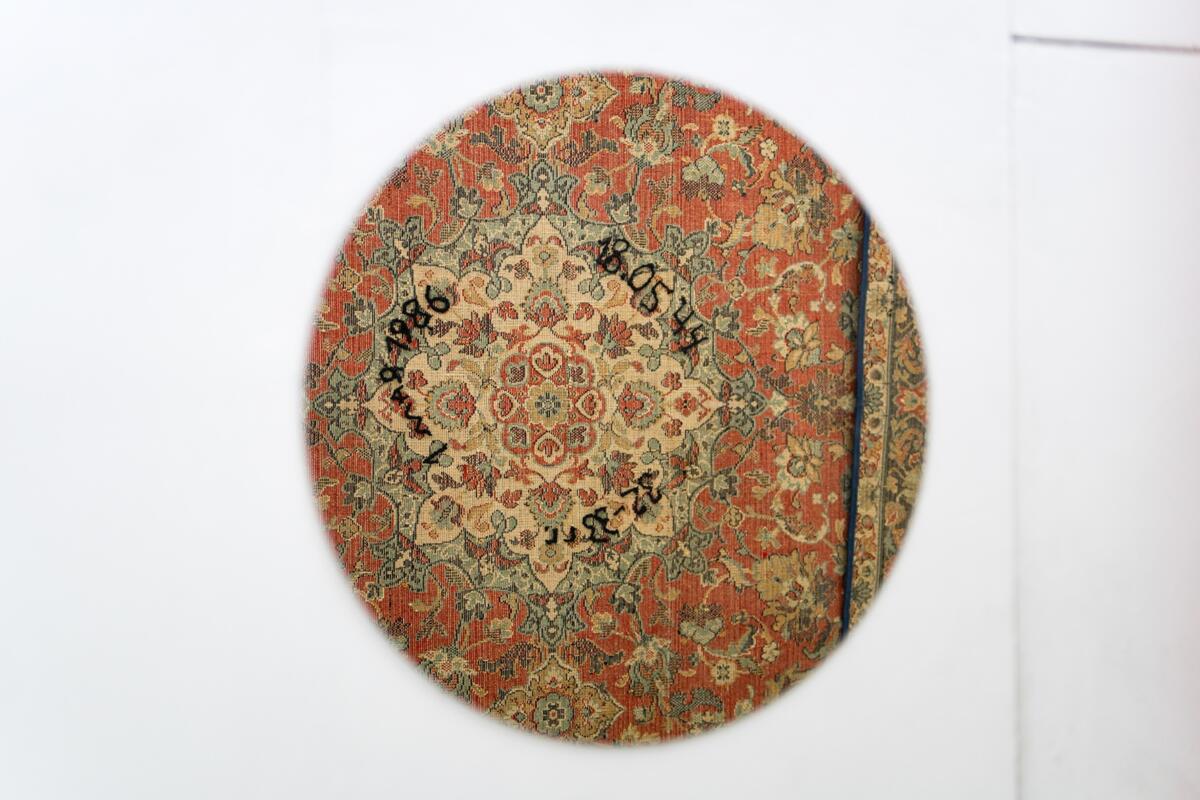
In 2015 I was invited to participate in the 6th moscow Biennale of Contemporary Art, curated by three European curators, Bart De Baere, Defne Ayas, and Nicolaus Schafhausen. My immediate reaction was to reject the invitation due to the ongoing war that russia started in Ukraine in spring 2014, but I was convinced that a dialogue could be developed. The question placed in the title of the Biennale was How to live together? This is the same question that I kept asking myself in moscow back then.
During the 10 day Biennale, a site-specific work had been created: an installation with a factory produced Soviet carpet from the late 80s, with hand embroidered numbers. Being unable to depict everything that happened in the Soviet Union during the 69 years of its existence, I chose three dates, representing three catastrophes that occurred in the Ukrainian Soviet Socialist Republic. Three completely different dates in terms of their nature, time, method, number of victims, and scale of consequence. For 10 days I embroidered these dates on the carpet, the dates that should be known, remembered and never repeated.
While talking about the object itself, about the Soviet-era carpet, as a metaphor of everyday life and the cultivation of nostalgia for the Soviet Union, including stalin as a new national hero in russia, many unexpected dialogues arose. Every day there were conversations with visitors of different ages. The dialogues (in a very Buberian sense) happened without an attempt to reach conclusions or express as many points of view as possible, but as “the very prerequisite of authentic relationship between an individual and an individual” [1]. My conversations often didn’t have a predefined purpose or agenda, but rather were a process of thinking aloud. I tried to talk with visitors about the tragedies that happened. Many still asked: “What was wrong with the Soviet Union?” “Why remember the bad?”



We spontaneously talked from our own experience, trying to leave debate and attempts to convince each other behind. The following dialogues were not the only ones that occurred but rather are the ones that I cannot forget:
“What happened on May 1, 1986?”
“Everybody in Ukraine and Belarus went to the Mayday parade. Nobody was notified about the danger coming from the Chernobyl catastrophe.”
“It was necessary.”
“Why?”
“My husband is military. I know it well. People would panic. Instead they were enjoying the sunny weather.”
“Everything went down with the fall of the Iron Curtain. The West is to blame.”
“Why?”
“Now Russia is full of murders, violence, abuse.”
“Do you think this wasn’t happening in the USSR?”
“It was, but at least we didn’t hear about it.”
“What are the numbers 1932-33?”
“A man-made famine, a genocide happened in the Ukrainian Soviet Socialist Republic in 1932—33. According to various sources, 2.5 to 5 million Ukrainians died of hunger.”
“That is not true.”
“My granny told me quite a few stories about how her family and neighbourhood tried to survive in Ukraine during those times.”
“Mine too. Nothing like that happened.”
“Where did your granny live in those times?”
“In Russia.”
“Soviet times were the best, everything was so easy and affordable.”
“Yes, but Soviet consumer goods didn’t have a big range and diversity.”
“That’s not true, all my friends had exquisite old furniture.”
“Were those items produced during Soviet times?”
“No, my friends bought them at the flea markets. Some of these friends were imprisoned afterwards.”
“What is this: 18.05.44?”
“The forcible deportation of the Crimean Tatars from the Crimea was ordered by Joseph Stalin and carried out on March 18th in 1944. A total of more than 240,000 people were deported in two days.”
“It would have been better if Stalin had killed them all back then.”
“What have these people done to you that you wish them dead?”
“I had some business in the Crimea in the ‘90s, I met some very unreliable Tatars.”
“Why do you come here to tell us how bad the Soviet times were?”
“I don’t, I just state the dates from the history.”
“Why do you eat our food and stay here if you don’t like it so much. The Soviet times were really great. Go back home, nobody asked you to come here!”
“How old are you, if I may ask?”
“22.”
“Stalin was a great personality. He did his best for the country.”
“But… the amount of victims of his regime outnumbers the amount of victims of WWII…”
“He did everything right. I personally support the ‘scorched earth’ principle. In my opinion, this strategy is efficient in both war and peace time.”
“What do you think about the current situation in the eastern Ukraine? I find it similar to that of Transnistria.”
“What do you think about the Transnistria conflict?”
“I am from there. I would be glad if we could be a part of Russia, and never Moldova.”
“Why?”
“Moldova is full of drug addicts.”
“Why do you think so?”
“I know it. They have drug rehab clinics, and we don’t.”
“What did you write in your message that will be buried in the performance?”
“I want to stop the killing of the children of Donbass.”
“Only the children?”
“Well, they announced on TV that kids are being crucified on crosses there.”
While recording the above dialogues for the installation at hoast, I was shocked to be confronted with what is now obvious. Since the beginning of the war in 2014, russian propaganda has continued to work to serve the purpose of validating and supporting the current escalation of the war on Ukraine. Social surveys assume that 71% of the russian population supports the war in Ukraine[2]: russians think they are “engaged in a heroic struggle with the West” and putin’s popularity ratings are as high as they were during the annexation of Crimea. It feels impossible to believe this after seeing footage from Ukraine, especially Bucha, Mariupol, Kharkiv, and hearing about the relentless bombing and the amount of civilian casualties in Ukraine. But it seems that half of the russian population acknowledges that the “special military operation”in Ukraine makes them feel proud, as they believe the narrative about the need to defend russian-language speakers in Ukraine, and the need to “denazify” and rid Ukraine of “nationalists”. Most of the war supporters are fervent consumers of russian television, radio and press, sources that are completely state-controlled. We have been isolated from what 144.1 million people have been told every day for the past 20 years. While each year on May 8th Ukraine and the rest of Europe commemorates WWII victims, saying “never again”, on May 9th, russia shows off its military strength (which is 60% financed by the taxes of its citizens) with the proud slogan “to Berlin again”.


russia invaded Ukraine on 24 February 2022, marking a major escalation of the war which began in 2014. This war has resulted in thousands of deaths and is the source of Europe’s largest refugee crisis since World War II, with more than 4.8 million Ukrainians leaving the country and 6.5 million people in Ukraine internally displaced to the Western part of the country. People, including the elderly and children, are forced to remain in transit zones for weeks, without the ability to find suitable shelter or regain any semblance of “normal” life. For this project, hoast tripled their standard artist fee so that it could be donated to the co-housing project co-Haty in Ivano-Frankivsk, initiated by the urban laboratory Metalab, for people who have lost their homes during this time of war. https://www.metalab.space/co-haty-eng
Edited by Katie Zazenski
Anastasiya Yarovenko born in 1983, grew up in Ukraine, lives and works in Vienna. She studied at the Academy of Fine Arts Vienna (2015) and also holds an MA in Theory of Literature and Comparative Studies (2006). In 2015 she took part in School of Kyiv – Kyiv Biennale 2015 and the 6th moscow Biennale of Contemporary Art. She received the Kunsthalle Wien Prize in 2015, she is also a recipient of the MAK Schindler 2016/2017 Scholarship Program. Select exhibitions include: Multiple Singularities, xhibit, Vienna (2020), If I only could, Köttinspektionen, Uppsala (2018), Amore, Sculpture Park, Vienna Museums Quartier (2017), Post-Peace, Württembergischer Kunstverein Stuttgart (2017); Final Projects: Group XLIII, Mackey Apartments, Los Angeles (2017); Preis der Kunsthalle Wien, Kunsthalle Wien Karlsplatz (2015/16).




[1]Martin Buber. I and Thou. Translated by Ronald Gregor Smith, published by Charles Scribner & sons, 1958
[2]Russians think they’re engaged in a heroic struggle with the West. Analysis by Dina Smeltz and Lily Wojtowicz for Washington Post, April 14, 2022. All the other data refer to the same article.
Imprint
| Artist | Anastasia Yarovenko |
| Exhibition | Why remember the bad? |
| Place / venue | hoast Vienna |
| Dates | April 30—May 15, 2022 |
| Website | www.hoast.net/hoast/ |
| Index | Anastasiya Yarovenko hoast |
